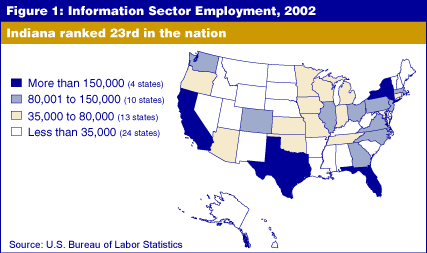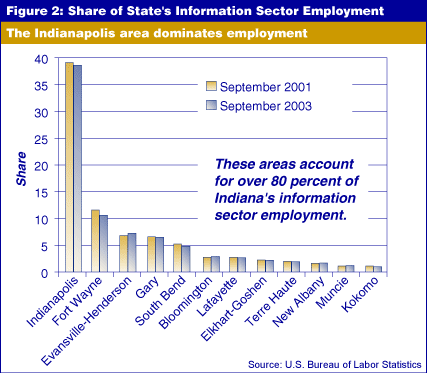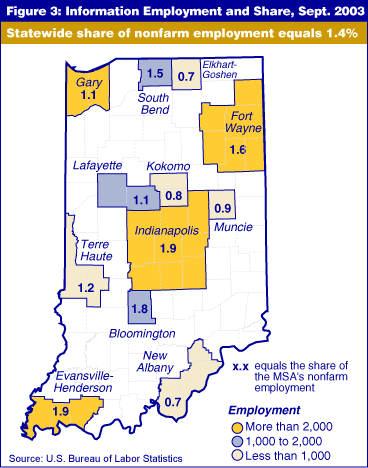Quantifying the Information Industry
With the conversion of the industry classification system from SIC to NAICS, the new information sector category fills the need for data on industries that create, disseminate or provide the means to distribute information. Previously, the data was widely dispersed throughout the SIC system, making analyzing the “information age” on an industry basis difficult, if not impossible. This new sector consolidates that data into seven subsectors:
- Publishing industries (except Internet)
- Motion picture and sound recording industries
- Broadcasting (except Internet)
- Internet publishing and broadcasting
- Telecommunications
- Internet service providers, web search portals and data processing services
- Other information services
Employment in the U.S. and Indiana
Between 2001 and 2002, the nation lost 209,000 jobs in the information sector, according to the non-seasonally adjusted Current Employment Statistics (CES), released by the Bureau of Labor Statistics. Approximately half of that decline came from three states—California, New York and Texas. Moreover, almost half of the national job loss occurred in the telecommunications subsector. Only two subsectors experienced growth during this time period—motion picture and sound recording industries and other information services (although employment growth in the motion picture industries countered the declines in the sound recording industries group).
Meanwhile, Indiana’s 2001 annual average employment in the information sector was 44,700, or 1.2 percent of the nation’s information sector employment. This ranked Indiana 23rd in the nation, tying with Connecticut. By 2002, Indiana’s annual average employment fell by 2,300 workers, but its rank and share of U.S. employment remained the same (see Figure 1). The telecommunications subsector (15,900) comprised 37.5 percent of Indiana’s information sector employment in 2002 and was responsible for approximately 35 percent of the decline in the information sector from 2001 to 2002.

In September 2003, the information sector employed 41,400 Hoosiers and had the second lowest share of Indiana’s total nonfarm employment (1.4 percent). From January 2003 to September 2003, Indiana’s loss of 100 information sector jobs was less severe than the nation’s, both numerically and on a percentage basis.
Hoosier Metros
Since CES collection procedures have not been updated to collect data for the newly defined metropolitan statistical areas, data is available for the pre-2003 metro areas (MSAs). Figure 2 shows each metro area’s share of the state’s information sector employment for September 2001 and September 2003. (Note: New Albany is the Indiana portion of the Louisville, Kentucky metro area.)

The Indianapolis MSA had 16,000 information sector employees, comprising 38.6 percent of the state’s information sector employment in September 2003 (see Figure 3). The Fort Wayne and Evansville-Henderson MSAs had the next two strongest footholds in the information sector, with 10.6 percent and 7.2 percent, respectively.

Indiana metro areas have 81.4 percent of the state’s employment in this sector. However, since September 2001, the non-metro portion of the state has increased its share of the information sector by 1.6 percentage points.
Indianapolis had the biggest absolute loss of jobs in this sector (-1,200), and Kokomo had the largest percent decline (-20 percent). Overall, the combined metro areas have lost 2,800 jobs in the information sector since 2001.
Limitations of the Data
Since 2001, the information sector has been hard hit and Indiana was not immune. CES data provides the most current numbers on this phenomenon, but sacrifices detail. Telecommunications is the only subsector included in the state data, leaving about 65 percent of Indiana’s information sector decline from 2001 to 2002 unaccounted for.
This leaves several unanswerable questions: Of the remaining six subsectors, did one stand out in terms of employment loss? Was the decline evenly distributed throughout the information sector? Was music file sharing or declines in music publishing the real culprits behind declining sector employment?
While the CES state data cannot help, one can look at the national level for some degree of analysis. The nation lost 2,800 workers in the sound recording industries group from 2001 to 2002, which included music publishers. Of the 12 industry groups disclosed under the information sector, the sound recording industries group had the fourth largest percentage decline between 2001 and 2002.
Amber Dodez-Kostelac
Data Manager, Indiana Business Research Center,
Kelley School of Business, Indiana University
